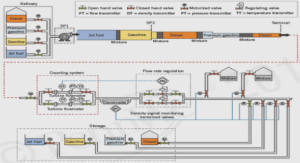Hydrogenated IPN Membranes
Synthesis of PECH10/PHEMA IPNs
Ex-situ PECH10/PHEMA IPNs presented in the first part of this chapter, were synthesized and characterized without air electrode. These syntheses and characterizations were made in parallel to the optimization of the PECH network synthesis and of the membrane/electrode assembly (MEA) discussed in Chapter II. For this reason, DABCO content was set at 10 mol % for the optimization of the PECH/PHEMA IPNs synthesis. For the same reasons, the assembly on the electrode of these new membranes has been done, at first, with the membranes synthesized in a mold and then placed on the electrode. An optimized procedure is presented in the next part of this chapter.
Experimental
The PECH10 network used in this part as reference corresponds to PECH10 network synthesized by molding in the previous chapter (cf. Chapter II § 2.2.2). In a typical synthesis, PHEMA network was synthesized by free radical polymerization by mixing 0.9 g 2-hydroxyethyl methacrylate (HEMA), 0.1 g ethylene glycol dimethacrylate (EGDMA – EGDMA:HEMA = 1:9 wt:wt) as cross-linker and 40 mg 2,2′-Azobis(2- methylpropionitrile) (AIBN – 4 wt.% with respect to monomers) as thermal initiator. The mixture was degassed under argon for 15 min and poured into a mold made from two silylated glass plates clamped together and sealed with a 500 µm thick Teflon® gasket (Figure II – 11). The mold was heated at 60 °C for 16 h and a homogeneous, rigid and transparent PHEMA network was obtained. The material was dried under vacuum at 60 °C for 24 h. The PECH10/PHEMA IPNs were synthesized by a one-pot process: in which all reactants are initially mixed. The PHEMA network is formed by free radical polymerization initiated with AIBN at 60 °C, and as seen in the previous chapter, the PECH is crosslinked at 100 °C by nucleophile substitution (Figure III – 1). 119 Figure III – 1: Scheme of PECH/PHEMA IPN synthesis For this, HEMA and EGDMA (EGDMA:HEMA = 1:9 wt.) were added to the PECH solution (18 wt.% in DMF, [DABCO]/[C-Cl] = 0.10) at the appropriate ratios for the desired composition of the IPN. For example, to synthesize a PECH10/PHEMA 68/32 IPN, 0.085 g EGDMA and 0.762 g HEMA (0.847 g of methacrylate monomers) were added to 10 g PECH solution (1.8 g PECH). The mixture was stirred under argon for 10 min and then 0.034 g AIBN were added (4 wt.% of methacrylate monomers). The solution was stirred under argon for 15 min more. The solution was then injected in the mold previously described, which was then heated, according to a non-optimized curing, at 60 °C for 16 h and at 100 °C for 2 h. IPNs with different PECH contents ranging from 37 to 90 wt.% were synthesized by keeping the same proportions between monomer, cross-linker and initiator for PHEMA network. All the materials were synthesized from 10 g PECH solution (18 wt.% in DMF) to which different HEMA and EGDMA amounts were added. All investigated PECH/PHEMA compositions are reported in weight ratio. The IPNs are noted PECHX/PHEMA y/z IPN where y and z are the weight proportions in the dry final material of PECH and PHEMA, respectively. The index X of PECH corresponds to the DABCO molar proportion in the PECH network.
Evidence of True IPN Architecture
The nucleophilic substitution and the radical polymerization reactions were chosen in order to synthesize these IPNs, assuming that they are non-interfering processes, without chain transfer reactions of radicals at the C-Cl bond of PECH, for instance. To confirm that no grafting reaction occurs between both networks during the IPN synthesis, three different semi-IPNs were synthesized. If no grafting reaction occurs, the linear polymer can be extracted quantitatively with DMF from each semi-IPN. These semi-IPNs were synthesized according to the same synthetic method as the IPNs. First, to obtain semi-IPNs in which PHEMA is linear, EGDMA was not added to the reaction mixture. The soluble fraction of the obtain material is equal to 32 wt.%, i.e. the weight proportion of HEMA included in the IPN synthesis. The soluble fraction has been identified by 13C NMR as linear PHEMA. This result shows that no grafting reaction occurred between the PHEMA and the PECH network. Second, a semi-IPN in which PECH is not crosslinked, 121 was synthesized. For that the cure at 100 °C was not carried out to avoid the cross-linking reaction of the PECH. The soluble fraction of this material is equal to 47 wt.% instead of the expected 62 wt.%. The soluble fraction was identified by 13C NMR as linear PECH. This result suggests that the PECH modified with DABCO can partially cross-link at 60 °C. To verify this assumption, a similar semi-IPN has been synthesized with linear PECH nonmodified with DABCO and the post-cure at 100 °C being maintained. In this case, the soluble fraction in DMF is equal to 72 wt.% confirming that linear PECH can be extracted from the PHEMA network. As the linear polymers can be quantitatively extracted from semi-IPNs, we can conclude that both networks are formed independently without any side reaction. The PECH does not play the role of chain transfer agent in the free radical polymerization of HEMA. As a result the synthesized materials can be considered as IPNs.



